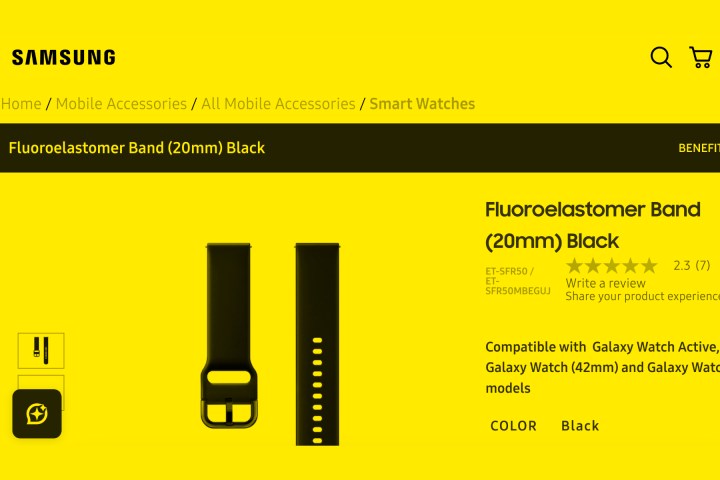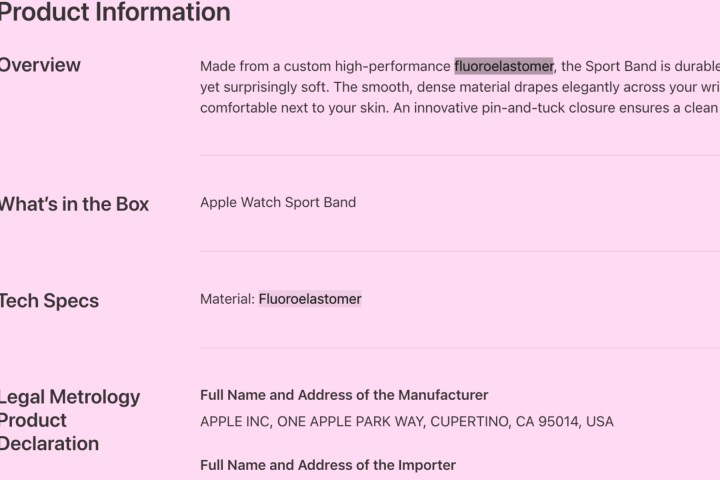Recently published research in the Advances in Infectious Diseases journal revealed that a staggering 95% of smartwatch and fitness tracker straps harbored harmful bacterial strains.
Following this, another study from the ACS’ Environmental Science & Technology Letters has highlighted an alarming discovery regarding wrist-worn smart wearables. The investigation has found perfluorohexanoic acid (PFHxA) contamination in fluoroelastomer bands from several leading brands.
The study evaluated bands from prominent manufacturers like Google, Samsung, Apple, Fitbit, and CASETiFY. Notably, both Samsung and Apple produce bands made from fluoroelastomers, emphasizing their supposed “advantages” on their product pages.
Researchers voiced concerns about “the extremely high levels of PFHxA that can be easily extracted from fluoroelastomer watch bands.” One troubling aspect is that consumers frequently wear these devices well beyond daily activities.
As more features such as sleep monitoring and apnea detection become commonplace, individuals are encouraged to don these devices during sleep. “Wearing these gadgets for hours, often exceeding 12 a day, presents a significant risk of skin absorption and subsequent exposure,” the researchers noted.
This is a serious threat

Notably, many of the tested straps were marketed towards fitness enthusiasts, implying regular use during exercise that could facilitate increased skin contact and open pores.
Apple, Samsung, and Google manufacture bands from fluoroelastomers.
This is particularly alarming considering that research indicates a remarkable 50% of PFHxA can be absorbed through the skin, with over a third entering the bloodstream. “It has been recorded that PFHxA ranks as the third highest concentration of PFAS found in blood samples,” the study revealed.
PFHxAs belong to a hazardous grouping of substances widely regarded as "forever chemicals" due to their persistent nature and tendency to resist natural breakdown in the environment. Their harmful effects are still not entirely understood.

These substances appear in a vast array of products, including cosmetics, cookware, clothing, and electronics, and have been in use for decades due to their resistance to heat, water, oil, and grease. However, their adverse effects have only recently come to light.
A significant volume of these chemicals can penetrate the skin during regular use.
Forever chemicals have been strongly associated with a myriad of health issues, including cancer, and their presence has been discovered in drinking water, soil, and even food. According to the U.S. Environmental Protection Agency, PFHxA is a byproduct of breaking down per- and polyfluoroalkyl substances (PFAS).
Expensive is not always good

The research specifically examined fluoroelastomers, a type of synthetic rubber created from PFAS, while searching for fluorine and other harmful chemicals. Surprisingly, the more expensive bands exhibited a higher concentration of dangerous chemicals compared to their lower-priced counterparts.
Out of the 22 bands studied, all fluoroelastomer bands contained detectable levels of fluorine. Notably, even those not explicitly made from fluoroelastomers showed fluorine traces, indicating potential PFAS contamination.
A subsequent extraction process confirmed PFHxA was the most prevalent forever chemical found in nine out of the 22 straps, with an average concentration of 800 parts per billion (ppb)—four times the amount typically found in cosmetics. In one instance, levels reached an alarming 16,000 ppb.
According to the research team, the high PFHxA levels in wristbands could stem from its role as a surfactant during the fluoroelastomer manufacturing process.
A large fraction of these chemicals can enter the bloodstream through the skin.
Alyssa Wicks, co-author of the study, advises consumers looking to minimize PFHxA exposure to consider lower-priced bands for their smart wearables. “If someone is keen on a pricier band, we recommend carefully reading product descriptions to avoid any mentions of fluoroelastomers,” Wicks stated. When shopping for wristbands, it's wise to stay clear of products containing fluoroelastomer.





